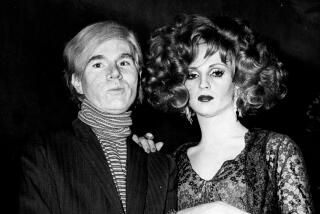Ah, How Sweet--and Addicting--It Is
- Share via
The Average Person ate 22.3 pounds of it last year.
The Average Person typically spends $64 a year on it.
And hey, you manufacturers, don’t think you can just up and make changes without hearing about it--The Average Person doesn’t take kindly to change.
We want our candy and we want it now. Never mind the lectures by our doctors and dentists. Last year, Americans ate the highest per capita amount ever reported, according to the National Confectioners Assn. of the United States. And that doesn’t even include gum, which tacks on another two pounds per person per year, according to the U.S. Department of Commerce, which collects the data.
We’re hooked and we know it.
“It’s awful; it’s sinful,” says Spanky Taylor, 42, of Burbank in a stage whisper right after buying a little of the sweet stuff at the Glendale Galleria. But on the heels of her guilt comes the familiar rationalization: “A lot of candy doesn’t contain a lot of fat. And I try to eat as little as I can,” says the self-appointed guardian of Gummi Bears.
That’s easier said than done because candy doesn’t just seem to be nearly everywhere. It is.
“Candy is one of the most widely distributed [food] products,” says Tricia Bowles, spokeswoman for Nestle Chocolate & Confections in Glendale. “Club stores, convenience stores, gas stations, theaters, groceries, drug stores. . . .”
And, of course, that doesn’t even count specialty shops such as Godiva or your grandmother’s candy dish with the glued-together hard mints or stealing from your child’s Halloween stash where all three of the Musketeers seemed to be calling your name.
Just how much is spent a year on candy? In the last year, Americans have spent a whopping $6.2 billion on candy just from drugstores, groceries and mass merchandise outlets, says Ray Wisbrock of Information Resources Inc., a Chicago-based market research firm. That’s up 7.8% from the previous year.
It’s not just availability that makes candy irresistible. Manufacturers of confectioneries-- which describes anything from granola bars to gum, hard candy, candy bars and upscale chocolates--pay their research and development folks to devise new and better ways to tempt us, year after year, season after season.
This year, one trend in kids’ candy is a product that combines sweet treats with toys and novelties--especially portable ones they can show off. Checkbook Bubble Gum, new from Amurol Confections Co., has pieces of gum the size of a check and printed with edible ink, says Amurol’s Gary Schuetz.
Bubble Lock looks like a real combination lock but actually contains gum balls. “We weren’t going to have the loop open,” says Schuetz, but members of the Candy Taster Club, a group of advisers 3,500 strong, convinced them otherwise. Kids said they wanted to hook the novelty lock onto their blue jean loops or their bikes.
While kids’ candy taste can best be described as adventurous, adults are less willing to try new products.
“Adults stick with more standard things,” says Susan Smith, spokeswoman for the National Confectioners Assn., a trade group based in McLean, Va.
Adults are likely, she says, to pick candy they liked from their childhood. So it’s not surprising that adults take it personally when an old favorite disappears. The recent debut of the blue M & M, for instance, and the simultaneous retirement of the tan M & M was not greeted with delight by everyone. One consumer, a longtime M & M fan, is still feeling the sting from the temporary retirement, years ago, of the red M & M, complaining that it upset her color-coded eating ritual.
“This is not uncommon,” says a representative for M & M-Mars. Consumers often talk of eating the candies in a certain way. “They often save their favorite color for last.”
Bowing to what they perceive as customer demand, some manufacturers have tried to appease the calorie-conscious, offering such bars as the Milky Way Lite, with about half the fat grams of other bars. But there’s something to be said for bucking a trend, as Nestle just discovered.
In September, it launched The Beast--much bigger versions of Baby Ruth and Butterfinger bars. At five ounces, they’re more than twice the size of traditional bars, Bowles says. In an era of moderation, who would eat this? Not surprisingly, teen-age boys are the prime customers. They don’t worry about the calories (680 each) and fat grams (28 to 32). Sales have been so brisk, Bowles says, that The Beast, intended as a onetime promotion, will be relaunched next year for a few months.
But not even The Beast could singularly satisfy anyone’s sweet tooth for long. “We figure everyone has about six favorite candies,” says Lisbeth Echeandia, publisher of Confectioner magazine, a trade publication in Dallas. That’s because different candies, she says, hit the spot at various times of day and for specific situations.
*
While Echeandia and others happily chomp on candy in public, many health-conscious adults are more discreet (read: sneaky) and indulge their sweet tooth only in private. But there are signs of that trend reversing, even among people who feel special pressure to stay svelte. When Kimberly Aiken, Miss America 1994, was asked about the origins of her boundless energy on a nationally televised show, she told the world about her Snickers habit--then about four a day (totaling 1,120 calories and 56 grams of fat).
“She started the whole family,” sighs her mother, Valerie, from her home in Columbia, S.C., who also acquired a love for the chewy chocolate and peanuts bar. Her daughter, now 21, has cut down, she adds.
Eating candy is frowned upon, of course, in certain quarters. Sugar works against you to lose weight, says Diane Grabowski-Nepa, registered dietitian at Pritikin Longevity Center, Santa Monica. While she generally steers her sweet-toothed clients to occasional servings of dried fruits and doesn’t indulge in sugary candy herself, she can see a role, albeit tiny, for candy. “If you are not trying to lose weight and if a little bit can work in your life, go for it.”
Often, though, she warns: “Eating sugar makes you want more sugar.”
As Sandra Crismond well knows.
Her son, Benjamin, points his tiny finger toward a see-through bin at Glendale’s Popcorn Palace and Candy Emporium. Minutes later, the San Fernando toddler clutches a small bag of sticky treats as Crismond debates the pros and cons of her 3-year-old’s candy habit. “He has candy at least three times a week,” she says. “He loves candy.”
She doesn’t worry that he will get fat. “I do worry,” she says, “about his teeth.” But overall, his diet is good. So, she asks herself, what harm could a little candy do?
It’s a question Inna Tseytlin has already asked and answered. Candy is forbidden at her ABC Educational Center, a Hollywood preschool. “No sugar, no candy,” she says firmly. “The parents get used to it.”
Meanwhile, the candy industry makes no apologies, reasoning that a balanced diet leaves room for a little fun. Says Bowles: “We bring a smile to people’s face. It’s a form of entertainment.”
Or, as Echeandia puts it: “Candy is a wolf in wolf’s clothing.”
More to Read
Inside the business of entertainment
The Wide Shot brings you news, analysis and insights on everything from streaming wars to production — and what it all means for the future.
You may occasionally receive promotional content from the Los Angeles Times.










